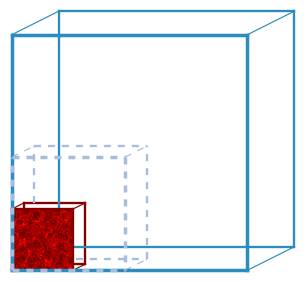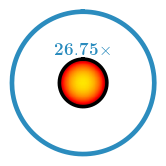Data Guide | Vishnu
This simulation is good for ...
- Modelling galaxies with stellar mass above ~10^7 Msun
- Resolving small structures with high time resolution
- Tracking orbits of subhaloes
- Testing temporal resolution effects on galaxy properties in semi-analytic models
Overview
The Vishnu simulation currently has the highest mass resolution of the N-body simulations available on TAO. Two versions of the merger trees are available, which roughly match the temporal resolution of the Millennium and Bolshoi simulations (63 and 178 snapshots, respectively). A "full resolution" version of the simulation with 1000 snapshots will be added to TAO soon. Vishnu was designed for the purpose of tracking subhalo orbits. The simulation and trees will be discussed in full detail in the upcoming paper by Sinha et al.
Relative size
- Box length: 130 h^-1 Mpc
The volume relative to Millennium and an all-sky survey out to z=0.05:

Mass resolution
- Particle mass: 3.215 × 10^7 h^-1 Msun
- Gravitational softening: 2.2 h^-1 kpc
- Number of particles: 1680^3
- Number of snapshots to z=0: 63 or 178
The particle size compared to Millennium:

Vishnu has 26.75 times higher mass resolution than Millennium, meaning a Vishnu halo contains 26.75 times the number of particles of a Millennium halo of equivalent mass.
Cosmology
The cosmological parameters for Vishnu are based on WMAP-1 data (Spergel et al. 2003).
- Ω_M = 0.25
- Ω_Λ = 0.75
- Ω_b = 0.04
- σ_8 = 0.9
- n = 1.0
- h = 0.7
Haloes
Haloes and subhaloes were identified using ROCKSTAR, with merger trees subsequently constructed with CONSISTENT-TREES. Vishnu includes subhaloes with as few as 2 particles.